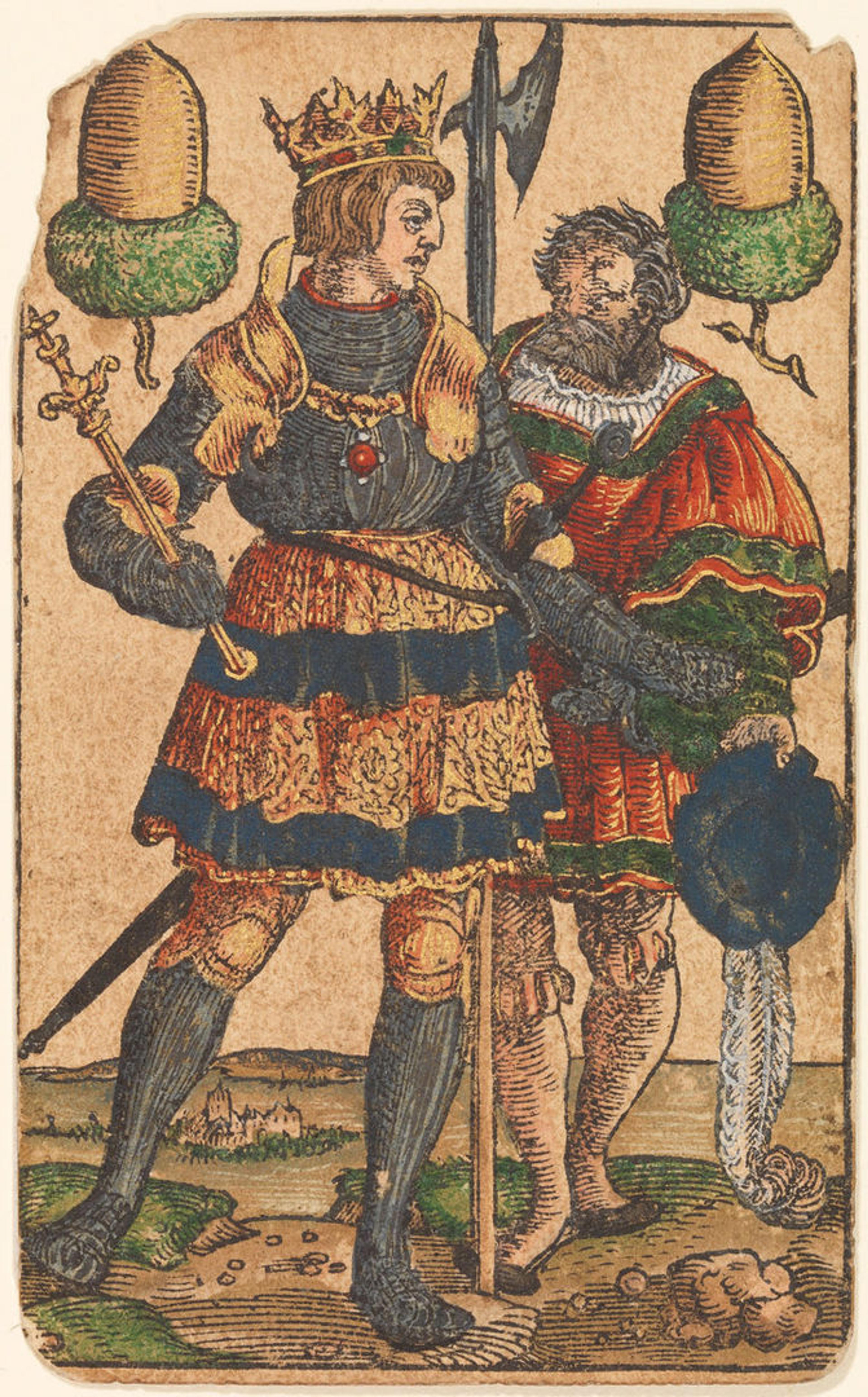
Peter Flötner (German, 1485–1546). King of Acorns (Maximilian I), from The Playing Cards of Peter Flötner, ca. 1540. Made in Nuremberg, Germany. Woodcut on paper with watercolor, opaque paint, and gold; the d'Este arms are hand drawn in pen and ink on the 2 of every suit; each card: 4 1/8 x 2 3/8 in. (10.5 x 5.9 cm). Germanisches Nationalmuseum, Nuremberg (GMN Sp 7418 1–47 Kapsel 516)
«Peter Flötner, who is thought to have trained in Augsburg before coming to Nuremberg in 1522, was one of the most gifted sculptors in that city. He was also an accomplished medalist, graphic artist, and designer of Renaissance ornament as well as all manner of decorative objects from household furnishings to outdoor fountains. Flötner produced relatively few woodcuts. The majority were for ornament, but he also made single sheets illustrating verses by Hans Sachs and various subjects aimed at the popular market, along with, in about 1540, what is arguably the most arresting deck of cards produced in post-Reformation Germany.»
The deck comprises the four, by this date, standard German suits: Acorns, Leafs, Hearts, and Bells, each with a king, upper and under knave, banner (10), and 9 through 2, for a total of 48 cards. Separate blocks were used for the suit symbols and the figural scenes; the cards of the deck were hand painted with watercolor and opaque paint, enhanced with white highlight and gold.
In this deck, the arms of the d'Este family of Ferrara—executed in pen and ink rather than woodblock and then colored—replace the figural scenes of the 2 of every suit. These are perhaps the arms of Francesco d'Este, brother of Ercole II, Duke of Ferrara and Modena. Francesco is known to have attended an imperial reception for Emperor Charles V in Nuremberg in 1541, an event for which Flötner designed a magnificent triumphal arch.
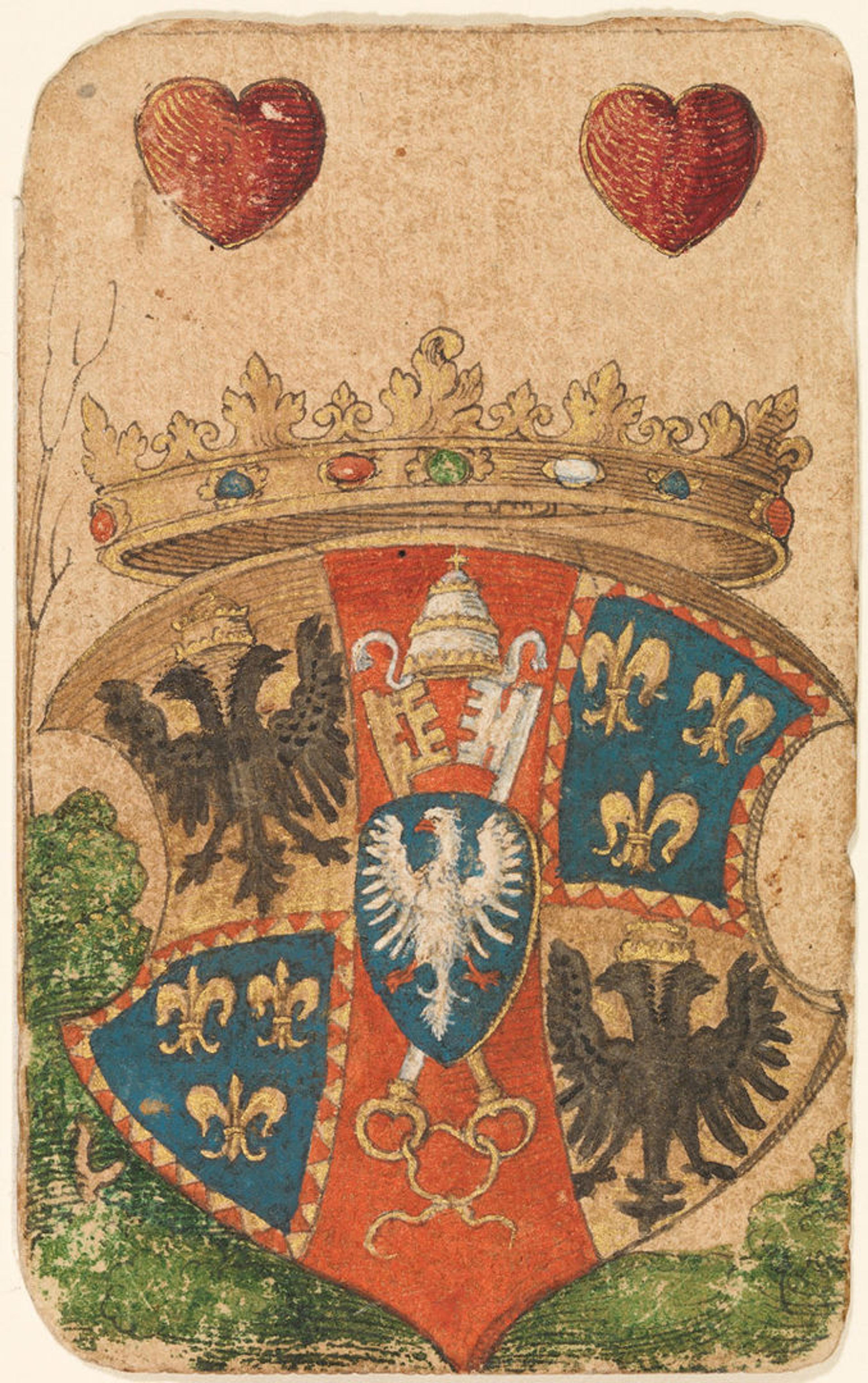
2 of Hearts, from The Playing Cards of Peter Flötner. Germanisches Nationalmuseum, Nuremberg (GMN Sp 7418 1–47 Kapsel 516)
The backs of the cards are inscribed with musical notation and lyrics, a feature unique to this deck. Each suit is a different voice: Acorns, bass; Leafs, tenor; Hearts, treble; and Bells, alto. They appear to be original to the deck, not added later, and together form four-part songs that are devoted to themes of love.
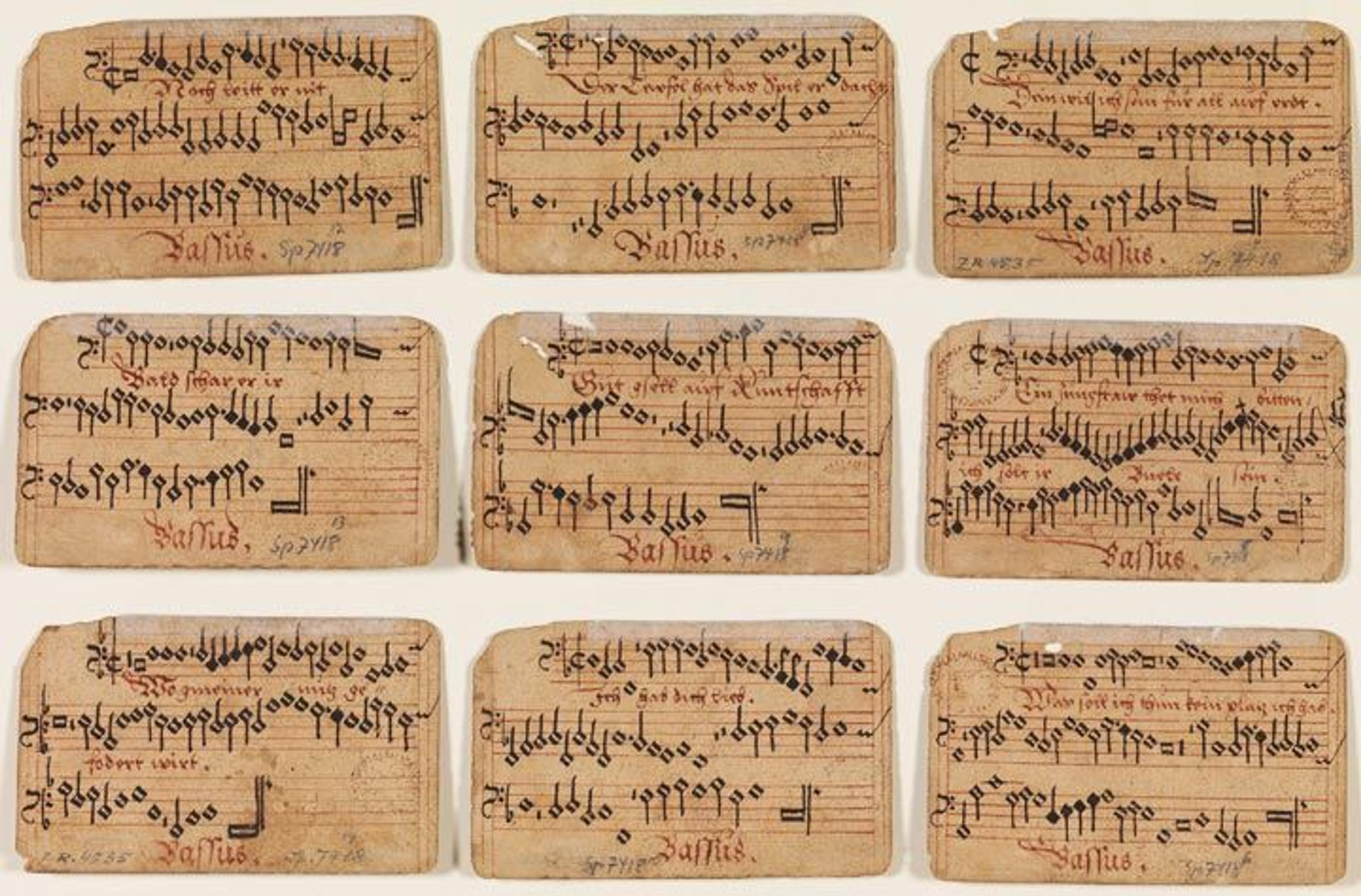
The backs of The Playing Cards of Peter Flötner show musical notations. Germanisches Nationalmuseum, Nuremberg (GMN Sp 7418 1–47 Kapsel 516)
Similar to The Courtly Household Cards, the knaves range in rank from court officials down to a fool. The upper knaves are all well-turned out in a manner appropriate to their office: master of the mint, secretary, cupbearer, and trombonist. In sharp contrast, the under knaves are from distinctly lower ranks of household functionaries: a messenger with a letter in hand, a large and unsavory cook with a pan in one hand and a large spoon in the other, a butcher, and a fool with a dripping nose, sausage in hand (a symbol of the linked sins of gluttony and lust), and jug on his hunched back, who clomps along wearing wooden pattens.
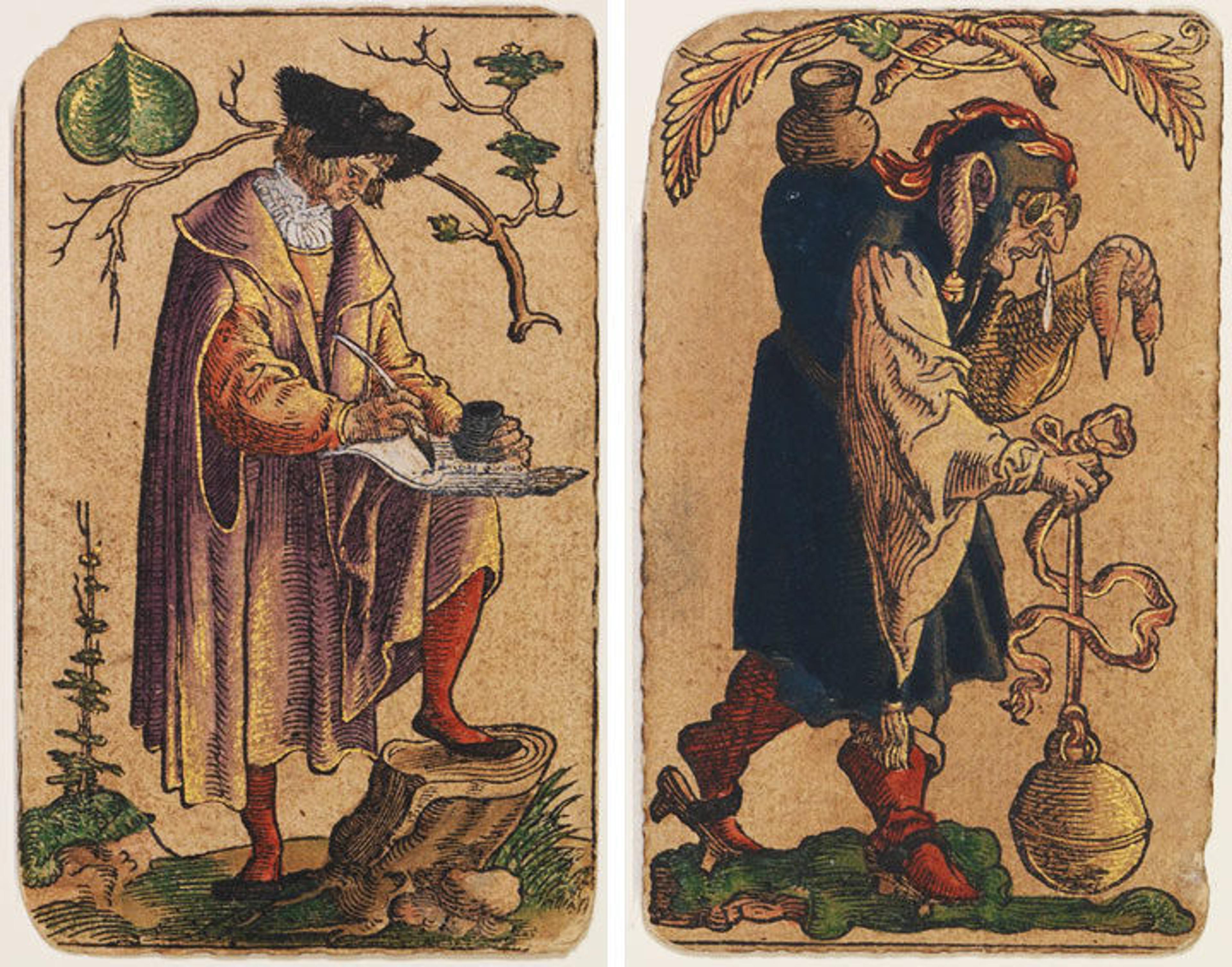
Upper Knave of Leafs and Under Knave of Bells, from The Playing Cards of Peter Flötner. Germanisches Nationalmuseum, Nuremberg (GMN Sp 7418 1–47 Kapsel 516)
Each suit in the Flötner deck is loosely connected to a theme. In Acorns, the scatological antics of pigs figure into five of the cards. (In popular culture, pigs were equated with lust and gluttony.) In Leafs, several scenes depict the perceived drunken and licentious behavior of peasants and farmers. Hearts are primarily concerned with the pastimes of the bourgeoisie, some innocent, others distinctly not. And a number of scenes in Bells address the futility of vain and foolish behavior.
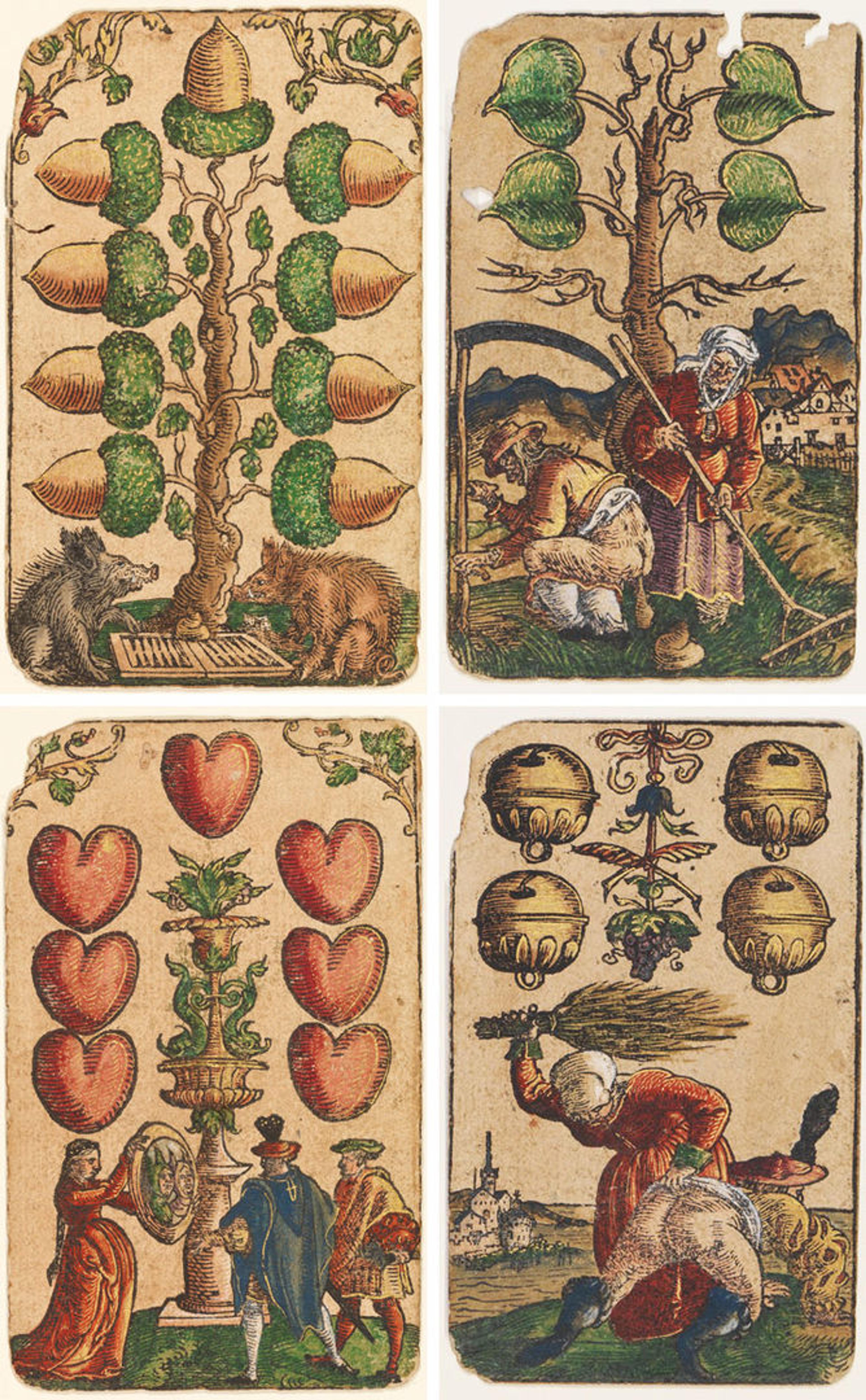
From left to right, top to bottom: The 9 of Acorns features two pigs playing trictrac (a version of backgammon); a mound of feces on the edge of the board is apparently the prize in play. The 4 of Leafs shows a farmer squatting and defecating while his wife inspects it with a rake. In the 7 of Hearts, A pregnant woman holds up a convex mirror to two gentlemen who are soliciting her, and two fools appear in the reflection. The 4 of Bells features a man who has lost money in a card game on all fours receiving a thrashing on his bared behind with a faggot wielded by his wife. Germanisches Nationalmuseum, Nuremberg (GMN Sp 7418 1–47 Kapsel 516)
Flötner certainly had in mind the didactic function of playing cards. The droll lucidity of his images are pungent reminders that card playing spawns all types of sin: gluttony, drunkenness, lust, greed, and folly. His cards effectively justified the denunciations of the clergy and the proscriptions of the civil authorities. Through the shock of images charged with biting social commentary, Flötner exhorted his audience to cleave to conventional moral dictates—a visual counterpart to much earlier moralizing allegories involving card playing. Flötner's emphasis on wanton behavior may also be a nod to Master Ingold's Das güldin Spil, a treatise which likened each of the most common games with one of the deadly sins—card playing being equated with unchastity.

A woman with a sausage on her nose solicits a young gentleman. 8 of Hearts, The Playing Cards of Peter Flötner. Germanisches Nationalmuseum, Nuremberg (GMN Sp 7418 1–47 Kapsel 516)
Flötner's striking cards bring to life a microcosmic view of a world long gone while animating social and moral themes that resonated then as they do to this day. More than any other artist, Flötner fully exploited the conceit of playing cards as a visual polemic to convey his worldview.
The Playing Cards of Peter Flötner bring this blog series to a close. As these are the smallest cards in the exhibition The World in Play: Luxury Cards, 1430–1540 (much smaller than the illustrations here), you have to look closely to see the narrative details. If you haven't had the chance to view this exceptional deck in person, hurry to The Met Cloisters before the exhibition closes on April 17.
Related Link